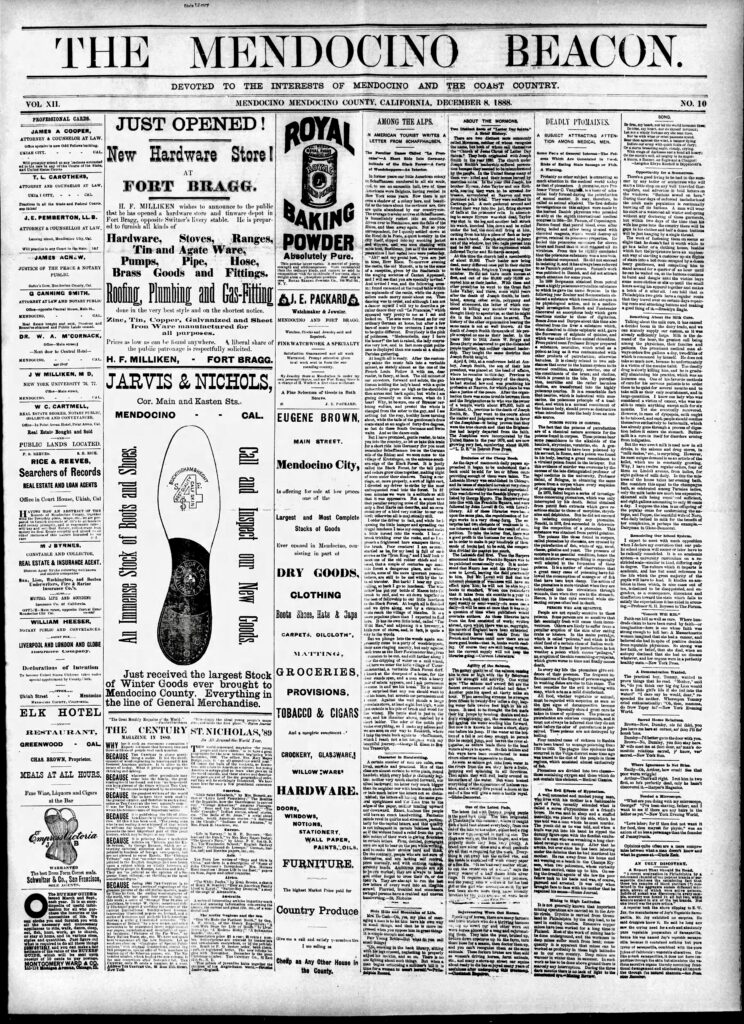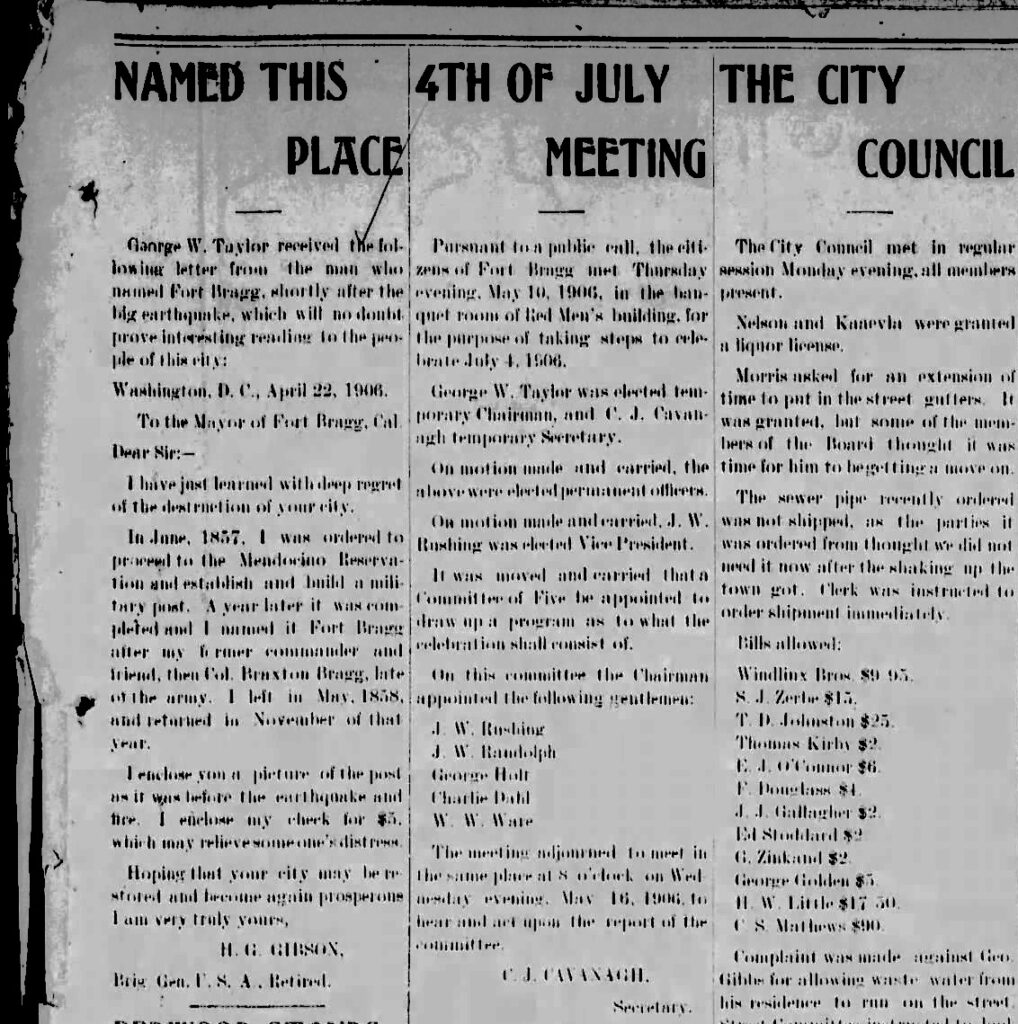Guest editorial: Fort Bragg name change would not be big deal and look good in history books

People change their names all the time. Many women take their husband’s name when they marry. Hippies took the names of animals or trees to show their affinity for nature and rejection of ‘the system.’. African Americans have rejected ‘slave names’ and taken African names. Sometimes people legally change their names to escape a notorious family legacy or even their own misdeeds.Towns and cities have also changed their names on a regular basis. The Corner became Kendall’s City which became Booneville and then Boonville. Greenwood became Elk. Meiggsville became Mendocino. Seven years ago, here in California, Confederate Corners was renamed Springtown. Google ‘city name changes’
and you will find hundreds of examples listed.
But why should our town of Fort Bragg change its name? Three reasons.
First because it memorializes a genocidal Fort that was established here in 1857.
(The main image comes from me, the editor, Frank Hartzell, not the author. In my search through old files for a dramatic story of the past about name change, I found this jewel, a letter from the guy who named Fort Bragg he wrote as an old man when he heard about Franklin Street getting wiped out in the 1906 Great Earthquake of San Francisco, which also caused havoc in Mendocino, including toppling the Point Arena Lighthouse.)
Local historian Katy Tahja has written ( An Electic History of Mendocino County): “Before the arrival of white settlers, the native peoples lived in an ecological paradise that provided everything they needed in a benign climate….Food surrounded them [fish and game]….The natural world that provided everything natives needed vanished with the arrival of white settlers. Chased from their lands, prevented from gathering food plants, and sold as slaves, by the 1860’s their world was gone.”
The establishment of the Fort was a scheme to defraud the US government: first the settlers attacked the native peoples, then they begged the Army to intervene to prevent a “massacre,” then they watched as troops herded natives onto the newly established Mendocino Indian Reservation. Then they stole all the land not included within the Reservation boundaries. Then they connived with government Indian Agents to use land within the reservation to build lumber mills and impress Indian labor for pennies on the hour, when wages were even paid.
Concentrated on the Reservation, forbidden to leave to hunt or fish, the natives relied upon government handouts for survival. When those same thieving Indian Agents supplied flour mixed with saw dust (diverting the real cost of flour to their own pockets) the Fort commander requested howitzers be sent in lest the starving Indians rise in rebellion.
White settlers sex trafficked young Indian girls and boys and the Reservation became known as the “US brothel.” See Robert Winn’s monograph The Mendocino Indian Reservation for documentation.
And when the’d gobbled up al the land outside the Reservation, the settlers, you know, those people after whom so many of Fort Bragg’s streets are named, connived with the Army to also feast upon the Reservation land by having the Indians evicted and marched out of their ancestral land and over the hill to Round Valley.
Secondly, because our namesake Braxton Bragg was a traitor and an enslaver. Bragg, a minor celebrity from the Mexican-American War, a US land grab of epic proportions, was out of the Army in 1857 when the Fort was named for him. But he was then a ‘southern planter’ who brutally worked 105 enslaved people 18 hours a day, 6 days a week, on his sugar plantation in Louisiana to become one of the richest men in the state. When he betrayed his country by becoming a General in the Confederate Army calls to change the name of our local fort began.
And thirdly because the name Fort Bragg was chosen for our city as a public mark of white supremacy. You see, by 1864 the old Fort had been decommissioned by the Army. Locals soon tore down 15 of its 16 buildings (one remains, on Laurel Street)
and repurposed the lumber for homes and barns.
In 1889, 25 years later the residents voted to incorporate as a city and had to choose a name. The Civil War was over. Everyone knew Bragg had been a traitor and an enslaver. The Fort had disappeared. By and large the Indians were gone. The new city residents could have chosen any name they pleased. But they consciously and deliberately chose to honor the Fort and Bragg as symbols of white supremacy.
That choice was part of a national moment. Union troops had been withdrawn from the South. Segregation, the Black Codes, and the KKK assured white power. In the north ‘Sun down towns’ passed ordinances to keep free Black people out. Anti-Chinese sentient led to massacres of Chinese workers in Oregon, Wyoming, and San Francisco.
Locally, Fort Bragg residents chased Chinese railroad workers out of town in 1892. The local chapter of the Ku Klux Klan burned crosses on Bald Hill in the 1920’s. The local movie theater showed “Birth of A Nation,” the most racist movie ever made in America, at special matinees for our school children. Black people were run out of town. Indian children were forced into boarding schools and stripped of their culture and language to “Kill the Indian, save the man.”
The history here was violent and genocidal. The name Fort Bragg is offensive because it white washes our history. A new name can be new beginning for our city. See more at changeournamefortbragg.comPhil Zwerling is a Fort Bragg resident and currently Chair of The Noyo Bida Truth Project

(Guest editorials are always welcome, but sometimes forgotten by the editor. Please remind me! They do not represent the views of the fine editorial board here at mendocinocoast.news)
Here is a picture of the main image again with the cutline and such removed so you can actually see the whole thing.

